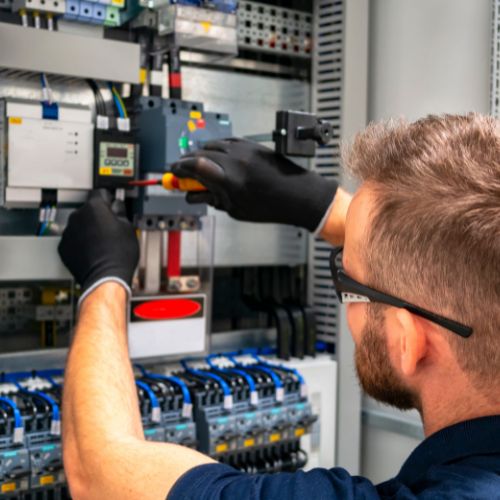
Common Electrical Upgrades for Older Homes
As homes age, their electrical systems may become outdated and unable to meet the demands of modern living. Common electrical upgrades for older homes are crucial to ensure safety, improve functionality, and enhance energy efficiency. By upgrading key components of the electrical system, homeowners can enjoy a reliable power supply, reduced fire hazards, and increased convenience. In this blog post, we will explore various electrical upgrades that are often recommended for older homes, shedding light on the benefits they bring and the considerations to keep in mind.
Rewiring:
One of the most significant electrical upgrades for older homes is rewiring. Many older homes were built with outdated wiring systems, such as knob and tube or aluminum wiring, which may pose safety risks. Rewiring involves replacing these old wiring systems with modern, safer alternatives like copper wiring. It not only ensures the safe delivery of electricity but also allows for the installation of additional outlets and lighting fixtures. A professional electrician can assess the existing wiring and recommend the appropriate rewiring approach tailored to the specific needs of your home.
Electrical Panel Upgrade:
Upgrading the electrical panel is another crucial electrical upgrade for older homes. Older electrical panels may have limited capacity, inadequate circuit breakers, or outdated fuses that can result in frequent tripping, overloaded circuits, or electrical hazards. An electrical panel upgrade involves replacing the old panel with a new one that offers increased capacity and improved safety features. This upgrade ensures that your electrical system can handle the power demands of modern appliances and electronics, reduces the risk of electrical fires, and provides better control over individual circuits.
Grounding:
Grounding is an essential safety feature that protects homeowners and their electrical equipment from electrical faults and surges. Older homes may have ungrounded electrical systems, increasing the risk of electric shock and damage to sensitive devices. Grounding involves the installation of grounding wires and grounding rods that redirect excess electrical energy safely into the ground. This upgrade helps prevent electrical shocks, enhances the performance of surge protectors, and provides a stable electrical reference point, improving the overall safety of your home’s electrical system.
Circuit Breaker Replacement:
Replacing outdated circuit breakers is another vital electrical upgrade for older homes. Older homes might have outdated or faulty circuit breakers that fail to trip during electrical faults or overload situations. This can result in overheating, electrical fires, or damage to appliances. Upgrading to modern circuit breakers, such as arc-fault circuit interrupters (AFCIs) and ground fault circuit interrupters (GFCIs), enhances protection against electrical hazards. AFCIs detect dangerous electrical arcs, while GFCIs provide protection against electric shock in areas prone to moisture, such as kitchens and bathrooms.
GFCI Installation:
Installing ground fault circuit interrupters (GFCIs) is a critical electrical upgrade, especially in older homes that lack this safety feature. GFCIs are designed to detect even minor imbalances in electrical current and quickly interrupt power to prevent electric shocks. By installing GFCIs in outlets near water sources, such as kitchens, bathrooms, and outdoor areas, you significantly reduce the risk of electrical accidents. GFCIs should be periodically tested to ensure proper functionality, and any GFCI outlets that do not trip or reset correctly should be promptly replaced.
Surge Protection:
Surge protection is crucial to safeguard your home’s electrical system and connected devices from power surges caused by lightning strikes or utility voltage fluctuations. Older homes may not have adequate surge protection, leaving electronics and appliances vulnerable to damage.
Whole Surge Protection:
Surge protection is crucial to safeguard your home’s electrical system and connected devices from power surges caused by lightning strikes or utility voltage fluctuations. Older homes may not have adequate surge protection, leaving electronics and appliances vulnerable to damage. Whole-house surge protection can be installed at the electrical panel to provide comprehensive protection by diverting excessive voltage safely to the ground. Additionally, individual surge protectors can be installed on specific outlets to protect sensitive devices like computers, televisions, and audio equipment. Investing in surge protection not only prevents costly damage but also extends the lifespan of your valuable electronics.
Outlet Replacement:
Replacing outdated and worn-out outlets is a simple yet effective upgrade for older homes. Older outlets may have loose connections, outdated designs, or lack of grounding, increasing the risk of electrical shock or fire. Upgrading to modern, grounded outlets with tamper-resistant features ensures a secure connection and protects against the accidental insertion of foreign objects. Furthermore, installing outlets with built-in USB ports adds convenience by eliminating the need for adapters or charging bricks. When replacing outlets, it is important to hire a licensed electrician to ensure proper installation and adherence to electrical codes.
Lighting Fixture Upgrade:
Upgrading lighting fixtures is not only an aesthetic improvement but also enhances energy efficiency and functionality. Older homes may have outdated and inefficient lighting fixtures that consume more energy and produce less light. Upgrading to energy-efficient LED fixtures not only reduces energy consumption but also provides better illumination. Additionally, installing dimmer switches allows for customizable lighting levels and can prolong the lifespan of your bulbs. Consider upgrading to smart lighting systems that offer remote control, scheduling, and integration with home automation systems, providing convenience and energy savings.
Knob and Tube Removal:
Many older homes were constructed with knob and tube wiring, which can be a safety concern. Knob and tube wiring consist of individual wires suspended by porcelain knobs and tubes, lacking the protective insulation used in modern wiring. Upgrading by removing the knob and tube wiring and replacing it with modern, safer alternatives is highly recommended. Not only does this eliminate the fire risk associated with aging and deteriorating wiring, but it also allows for the installation of additional outlets and meets the electrical demands of modern appliances and technology.
Aluminum Wiring Replacement:
Another common issue in older homes is the presence of aluminum wiring. Aluminum wiring was widely used in the 1960s and 1970s but is now known to have potential safety hazards due to its tendency to expand and contract, leading to loose connections and increased fire risks. Replacing aluminum wiring with copper wiring is an essential electrical upgrade. Copper wiring offers better conductivity and is less prone to heat-related issues, providing a safer and more reliable electrical system.
Whole-house Rewiring:
In some cases, older homes may require a complete rewiring project to ensure the safety and functionality of the electrical system. Whole-house rewiring involves replacing all electrical wiring throughout the property. While it is a significant undertaking, it provides numerous benefits, including enhanced safety, increased capacity, improved energy efficiency, and compliance with modern electrical codes. A professional electrician can assess the condition of your home’s wiring and recommend a whole-house rewiring project if necessary.
Electrical Code Compliance:
Upgrading an older home’s electrical system often involves ensuring compliance with current electrical codes. Electrical codes are regularly updated to address safety concerns and technological advancements. By bringing your home up to code, you not only ensure the safety of your family and property but also avoid potential legal issues when selling or insuring your home. Electrical code compliance may involve various upgrades, such as installing AFCIs (Arc-Fault Circuit Interrupters) in bedrooms, GFCIs (Ground Fault Circuit Interrupters) in bathrooms and kitchens, proper spacing and grounding of outlets, and adequate lighting and ventilation in specific areas. Consulting with a licensed electrician is essential to ensure that your electrical upgrades meet the requirements of the latest electrical codes.
Junction Box Installation:
Properly installed junction boxes are vital for electrical safety in older homes. Junction boxes provide a secure enclosure for electrical connections, preventing exposure to live wires and reducing the risk of electrical hazards. In older homes, you may find uncovered or outdated junction boxes or even junctions made without boxes. Upgrading your home’s electrical system involves installing new junction boxes and ensuring that all electrical connections are safely contained within them. This ensures easy access for future maintenance, protects against potential fire hazards, and keeps the electrical system organized and efficient.
Electrical Outlet Grounding:
Grounding electrical outlets is an essential upgrade for older homes. Ungrounded outlets increase the risk of electrical shock and may not be compatible with modern appliances and electronic devices that require grounding for proper operation. Grounding outlets involves installing a grounding wire and connecting it to the home’s grounding system. This provides a safe pathway for electrical currents in case of a fault, redirecting it harmlessly to the ground. Grounded outlets not only improve safety but also ensure the reliable and stable operation of your electrical devices, reducing the risk of damage or malfunctions.
Wiring Inspection:
Before embarking on any electrical upgrades for an older home, it is crucial to conduct a thorough wiring inspection. A professional electrician can assess the condition of the existing wiring, identify potential safety hazards, and determine the overall health of the electrical system. The inspection may reveal issues such as frayed wires, damaged insulation, improper connections, or overloaded circuits. By conducting a comprehensive wiring inspection, you can address any underlying issues and ensure that your electrical upgrades are built upon a solid foundation, providing optimal safety and performance.
Electrical System Modernization:
Modernizing the electrical system of an older home involves incorporating smart technologies and automation for improved convenience, energy efficiency, and control. This can include installing smart thermostats, programmable lighting systems, voice-activated assistants, and home automation hubs. These upgrades allow for remote control, energy monitoring, and scheduling, enabling homeowners to optimize energy usage and reduce utility costs. Modernizing the electrical system also involves integrating renewable energy sources such as solar panels and battery storage, promoting sustainability and reducing reliance on the grid.
Fuse Box Upgrade:
Replacing an outdated fuse box with a modern circuit breaker panel is a critical electrical upgrade for older homes. Fuse boxes, commonly found in older properties, have limited capacity and can be prone to blown fuses, increasing the risk of electrical overloads and fire hazards. Upgrading to a circuit breaker panel provides better protection, increased capacity, and easier management of circuits. Circuit breakers automatically trip during an overload or short circuit, cutting off power to the affected circuit. This eliminates the need to replace fuses and enhances the safety and efficiency of the electrical system.
AFCI Installation:
Arc-Fault Circuit Interrupters (AFCIs) are devices designed to detect dangerous electrical arcs, such as those caused by damaged wires or loose connections, and quickly interrupt the power to prevent fires. Installing AFCIs is an essential electrical upgrade for older homes as they significantly enhance fire safety. AFCIs can be installed at the circuit breaker panel or as AFCI outlets. They provide protection against electrical faults that can occur in areas such as bedrooms, living rooms, and dining rooms where arc faults are more likely to happen. AFCIs help prevent electrical fires, providing peace of mind for homeowners and protecting their property.
Dimmer Switch Installation:
Installing dimmer switches is a popular electrical upgrade that offers both functionality and energy efficiency. Dimmer switches allow you to adjust the intensity of lighting, creating ambiance and saving energy. Older homes often have standard on/off switches that do not provide this flexibility. Upgrading to dimmer switches not only enhances the aesthetics of your living spaces but also extends the lifespan of light bulbs. By reducing the brightness level, you can save on energy consumption and lower your electricity bills. Dimmer switches are available in various styles and can be easily installed by a qualified electrician.
Ceiling Fan Installation:
Adding ceiling fans to older homes is a practical and energy-efficient electrical upgrade. Ceiling fans provide cooling and improved air circulation, reducing the reliance on air conditioning and lowering energy costs. Older homes may not have pre-installed ceiling fan fixtures, but they can be added to existing light fixtures or in rooms with sufficient support structures. Installing ceiling fans with adjustable speeds and reversible functions allows for year-round comfort, as they can help distribute warm air during winter months. Consult with an electrician to ensure proper installation and consider choosing fans with energy-efficient motors for additional savings.
Electrical Outlet Relocation:
In older homes, electrical outlets may not be conveniently located to accommodate modern needs. Relocating outlets can enhance functionality and convenience. For example, relocating outlets near countertops in the kitchen or adding outlets in home offices can eliminate the use of extension cords and reduce clutter. When relocating outlets, it is crucial to consult with a professional electrician to ensure that the electrical wiring is properly rerouted and that the new outlets meet electrical code requirements. Proper planning and installation can make a significant difference in improving the usability and efficiency of your home’s electrical system.
Outdoor Lighting Installation:
Enhancing outdoor lighting is an essential electrical upgrade for older homes, improving security, safety, and aesthetics. Well-placed outdoor lighting can deter intruders, increase visibility around the property, and create a welcoming ambiance. Installing motion-sensor lights near entrances and pathways adds an extra layer of security and convenience. Additionally, energy-efficient LED outdoor lighting reduces energy consumption and maintenance requirements. Consider installing landscape lighting to highlight architectural features, gardens, or pathways. With various options available, including solar-powered lights, low-voltage lighting systems, and smart lighting controls, you can customize your outdoor lighting to suit your specific needs and preferences.
Smoke Detector Installation:
Ensuring proper smoke detector coverage is a crucial safety upgrade for older homes. Smoke detectors play a vital role in alerting occupants to the presence of smoke or fire, providing valuable time for evacuation. Older homes may have outdated or insufficient smoke detection systems, making it necessary to upgrade and expand their coverage. Install interconnected smoke detectors on each level of the home and in every sleeping area, ensuring that they are hardwired with battery backup for reliable operation. Regularly test and maintain smoke detectors to ensure they are in proper working order and replace them according to the manufacturer’s manual.
Electrical Grounding for Appliances:
Many older homes may have appliances that lack proper grounding. Grounding appliances is essential for safety and helps protect against electrical shock. Grounding involves connecting the metallic parts of an appliance to the grounding system of your home. Upgrading the electrical system of older homes should include ensuring that all major appliances, such as refrigerators, stoves, and washing machines, are properly grounded. This reduces the risk of electrical malfunctions and improves the overall safety of the appliances. Consult with a licensed electrician to evaluate the grounding of your appliances and make necessary upgrades.
Electrical System Load Assessment:
As you consider electrical upgrades for your older home, it’s important to assess the overall electrical load to ensure it can handle the demands of modern appliances and technology. Older homes may have electrical systems designed for a lower power capacity, which can lead to overloaded circuits, tripped breakers, or flickering lights. An electrical load assessment by a qualified electrician can determine if your current system can handle the load or if upgrades are necessary. This assessment involves evaluating the electrical panel, wiring, and individual circuits to ensure they meet the power requirements of your home and avoid potential hazards.
Conclusion:
Common electrical upgrades for older homes are essential for safety, functionality, and energy efficiency. From rewiring and panel upgrades to grounding, circuit breaker replacements, and outlet installations, these upgrades bring numerous benefits, including improved safety, enhanced convenience, and reduced energy consumption. By investing in these electrical upgrades, homeowners can modernize their electrical systems, meet current electrical codes, and enjoy the benefits of a reliable and efficient electrical infrastructure. Consulting with a licensed electrician is crucial to assess the specific needs of your home and ensure that the upgrades are carried out safely and effectively.


